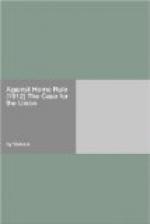of the Synod of that Diocese, last September, showed
that both the principal churches and the endowments
now held by the Church of Ireland have been claimed
repeatedly by prominent representatives of the Church
of Rome. It is stated that the Church sites and
buildings belong to the Roman Communion in Ireland
because, on Roman Catholic principles, that communion
truly represents the ancient Irish Church, and no
lapse of time can invalidate the Church’s title;
and that the endowments belong to the same communion
because they “represent moneys derived from pre-Disestablishment
days, which were, in their turn, the alienated possessions
of the Roman Church” (see Bishop of Ossory’s
Synod Address, p. 7). As regards this last statement,
it must be noted that the only sense in which it can
be truly said that the endowments represent moneys
derived from pre-Disestablishment days is that the
foundation of the new financial system was laid by
the generosity of the clergy in office at the time.
They entrusted to the Representative Body of the Church
the capitalised value of the life-interests secured
to them by the Act. The money was their private
property, and their action one which involved great
self-denial, for they gave up the security offered
by the State. The money was so calculated that
the whole should be exhausted when all payments were
made. By good management, however, it yielded
considerable profit, and meanwhile formed a foundation
on which to build. It was, however, in no sense
an endowment given by the State, nor was it a fund
on which any but the legal owners (
i.e. the
clergy of the time) had a justifiable claim.
The Bishop of Ossory’s statement excited much
discussion, but, though many Roman Catholic apologists
endeavoured to laugh away his fears as groundless,
not one denied the validity of his argument. The
fact that, as he showed, the Church of Ireland holds
her churches by exactly the same title as that by
which the English Church holds Westminster Abbey,
and that, for the Irish Church, there is the additional
security of the Act of 1869, count for nothing in
the eye of Roman Canon Law.
In an Ireland ruled by a Parliament of which the vast
majority would be Roman Catholics, devout and sincere,
representing constituencies peopled by devout and
sincere persons who believe that the laws of the Vatican
are the laws of God, with a clergy lifted above the
civil law by the operation of the recent Motu Proprio
Decree, an Ireland in which even the school catechisms
(see the “Christian Brothers’ Catechism,”
quoted by the Bishop of Ossory, op. cit. p.
8) teach that an alien Church unlawfully excludes
“the Catholics” from their own churches,
how long would it be before a movement, burning with
holy zeal and pious indignation, against the usurpers,
would sweep away every barrier and drive out “the
heretics” from the ancient shrines?
Irish Churchmen who know their country are aware that
even the most stringent guarantees would be worthless
in such a case, as they proved worthless in the Act
of Union, and at the time of Catholic emancipation.




